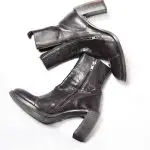Do you ever pull a freshly laundered shirt out of the dryer, only to find water marks all over it? It can be frustrating and even embarrassing to wear clothes with unsightly stains. But what causes these water marks in the first place?
Water marks on clothes can be caused by a variety of factors, including the type of detergent you use, the hardness of your water, and even the way you load your washing machine.
In this article, we will break down the different causes of water marks and provide you with tips on how to prevent them from happening in the future.
So, grab a cup of coffee and let’s dive into the world of laundry stains.
Table of Contents
Understanding Water Marks
Ever wonder why those pesky water marks show up on your clothes? Let’s dive into understanding why.
Water marks are caused by the minerals present in the water that we use to wash our clothes. When the water evaporates from the fabric, the minerals are left behind, causing the unsightly marks.
These marks are more commonly seen on dark-colored clothes because the minerals are more visible on them. Hard water, which contains a high concentration of minerals, is also more likely to leave water marks on clothes.
If you live in an area with hard water, it’s important to take extra care when washing your clothes to avoid these marks. To prevent water marks from appearing on your clothes, try using a water softener in your washing machine.
You can also try using distilled water to wash your clothes or adding a cup of white vinegar to the wash cycle to help remove any mineral buildup. By understanding the cause of water marks and taking steps to prevent them, you can keep your clothes looking clean and fresh.
The Role of Detergent
You can easily prevent those pesky stains on your favorite outfits by choosing the right detergent. When it comes to preventing water marks on clothes, the type of detergent you use plays a crucial role.
Here are some things to keep in mind:
- Look for detergents that are specifically designed to remove water marks.
- Choose a detergent that is gentle on fabrics and doesn’t contain harsh chemicals that can damage your clothes.
- Consider using a fabric softener or conditioner to help prevent water marks from forming.
- Use the correct amount of detergent according to the instructions on the label to ensure that your clothes are properly cleaned.
- Avoid using too much detergent, as this can leave residue on your clothes that can attract dirt and cause water marks to form.
By following these simple tips, you can keep your clothes looking clean and fresh without having to worry about unsightly water marks.
Remember to always read the label on your detergent to ensure that it’s suitable for the type of fabric you’re washing, and always use the recommended amount to get the best results.
With the right detergent and a little bit of care, you can keep your clothes looking great for years to come.
The Impact of Hard Water
Hey there, did you know that using hard water can actually affect how well your detergent works and can lead to less than perfect results on your laundry?
Hard water contains high levels of minerals like calcium and magnesium, which can cause soap to form a scum instead of creating suds. This scum can then stick to your clothes, leaving a residue that appears as watermarks after the wash.
When you use hard water to wash your clothes, the minerals in the water will combine with your detergent and form a layer of soap scum. This layer can build up over time and prevent your detergent from properly cleaning your clothes.
As a result, you may notice that your clothes look dull and faded, and may even have a strange odor.
To combat the impact of hard water on your laundry, consider using a water softener. This device can remove the minerals from your water, leaving it soft and better suited for washing clothes.
Additionally, you can also try using a laundry detergent that is specifically designed for hard water. These detergents contain ingredients that can help break down the minerals and prevent soap scum buildup.
By taking these steps, you can ensure that your clothes come out looking fresh and clean every time you do laundry.
Proper Loading Techniques
To ensure the best possible results, it’s important to load your washing machine correctly. Proper loading techniques may seem like a minor detail, but they can actually affect the cleanliness of your clothes.
Firstly, make sure to separate your clothes by color and fabric type. This prevents any color bleeding and ensures that your clothes receive the appropriate amount of agitation.
Secondly, don’t overload your washing machine. It may be tempting to stuff as many clothes as possible into one load, but this can actually hinder the cleaning process. Overloading can cause clothes to not get fully submerged in water, which leads to uneven cleaning and potential water marks. Always check your machine’s manual for the recommended load size and stick to it.
Lastly, consider the placement of your clothes in the machine. Heavier items, like towels and jeans, should be placed on the bottom, while lighter items, like t-shirts and underwear, should be placed on top. This creates a balanced load and prevents heavier items from crushing lighter ones.
Overall, proper loading techniques can make a big difference in the cleanliness and longevity of your clothes. Take the time to do it right and you’ll see the results in your wardrobe.
The Importance of Rinse Cycles
When doing laundry, it’s important to make sure your washing machine includes a rinse cycle that removes any remaining detergent and dirt from your clothes, leaving them fresh and clean. Without a proper rinse cycle, your clothes can end up with water marks that are difficult to remove.
Here are five reasons why the rinse cycle is so important:
- Removes excess detergent: If your clothes aren’t properly rinsed, excess detergent can stay trapped in the fibers of the fabric, causing water marks to appear.
- Gets rid of dirt: Dirt and grime can also cause water marks if not thoroughly removed during the rinse cycle.
- Prevents fabric damage: Leftover detergent and dirt can cause fabric to weaken and become damaged over time, making it more susceptible to water marks and other stains.
- Eliminates odors: A good rinse cycle helps to eliminate any lingering odors from your clothes, leaving them smelling fresh and clean.
- Keeps colors bright: Residual detergent can cause colors to fade and become dull over time. A proper rinse cycle ensures that all detergent is removed, keeping your colors bright and vibrant.
So, always make sure your washing machine has a proper rinse cycle to avoid water marks and keep your clothes looking and smelling their best.
Addressing Water Mark Stains
Dealing with those pesky stains left behind on your favorite garments can be a frustrating experience. Water marks, in particular, can be tricky to remove. These stains are caused by mineral deposits from hard water that settle on clothes during the washing process.
Fortunately, there are a few simple steps you can take to address water mark stains. To start, try re-washing the garment using a different detergent. Sometimes, water marks are caused by soap residue that wasn’t completely washed away. Switching to a different detergent can help break down any remaining soap and prevent future water marks.
Additionally, consider adding a water softener to your washing machine to reduce the amount of mineral deposits left on clothes. If re-washing and using a different detergent doesn’t work, try soaking the garment in a mixture of vinegar and water. The acid in the vinegar can help dissolve the mineral deposits causing the water marks.
Simply mix equal parts white vinegar and water in a bowl or sink and let the garment soak for about 30 minutes. Then, wash the garment as usual and check to see if the water mark has disappeared. Water marks can be a frustrating stain to deal with, but don’t give up on your favorite clothes just yet! By trying a different detergent or soaking the garment in a vinegar and water mixture, you can effectively remove those stubborn stains and keep your clothes looking new.
Preventing Future Water Marks
If you want to prevent water marks on your clothes, there are a few things you can do. First, be sure to properly care for and maintain your garments. This includes following washing instructions, avoiding harsh chemicals, and drying clothes correctly.
Additionally, you can take preventative measures like using water-resistant sprays or wearing protective clothing when in contact with water.
Tips for preventing water marks
To avoid water marks on your clothes, you should try using fabric softener or dryer sheets to reduce static cling and prevent water from sticking to the fabric. Another tip is to avoid overloading the washing machine, as this can cause clothes to bunch up and prevent water from evenly distributing throughout the load. Here are some additional tips to keep in mind:
| Tip | Description |
|---|---|
| Wash similar fabrics together | This ensures that all the clothes in the load have similar water absorption rates. |
| Use the correct water temperature | Hot water can cause colors to fade and shrink fabrics, while cold water may not effectively remove stains. |
| Hang clothes to dry | This can prevent water marks from forming due to the clothes being scrunched up in a dryer. |
| Iron clothes immediately after washing | This can help to smooth out any wrinkles or water marks that may have formed. |
| Avoid using too much laundry detergent | Overuse of detergent can cause residues to form on clothes, which can attract water and cause marks. |
By following these tips, you can prevent water marks from forming on your clothes and keep them looking fresh and clean after every wash. Remember to keep an eye on your washing habits and adjust them as necessary to ensure the best possible results.
Proper garment care and maintenance
Maintaining the quality of your garments is essential for ensuring their longevity and keeping them in excellent condition. Proper garment care and maintenance are crucial to preventing water marks from appearing on your clothes. Here are four tips to help you ensure your clothes remain looking their best.
-
Follow the care label instructions. Before washing your garments, check the care label instructions and follow them carefully. Each garment has specific washing instructions that may include machine-washing, hand-washing, dry-cleaning, or a combination of these methods.
-
Use the right detergent. Choose a detergent that’s appropriate for your garments and the type of water you have. Hard water can cause mineral buildup, which can leave water marks on your clothes. Using a water softener or choosing a detergent that’s formulated for hard water can help prevent this.
-
Avoid overloading the washing machine. Overloading the washing machine can cause friction between the garments, leading to damage and water marks. It’s best to wash your clothes in small batches to ensure they have enough room to move freely in the machine.
-
Air-dry your clothes. Drying your clothes in a dryer can cause the fibers to shrink and become damaged. Instead, hang your clothes to dry on a clothesline or drying rack. This will not only prevent water marks but also help maintain the quality of your garments.
By following these tips, you can help prevent water marks from appearing on your clothes and ensure that they remain in excellent condition for years to come.
- Innovations in Moisture-Wicking Textiles - July 18, 2024
- Engineering Fabrics for Optimal Performance - July 18, 2024
- The Science of Breathability in Fabrics - July 18, 2024






